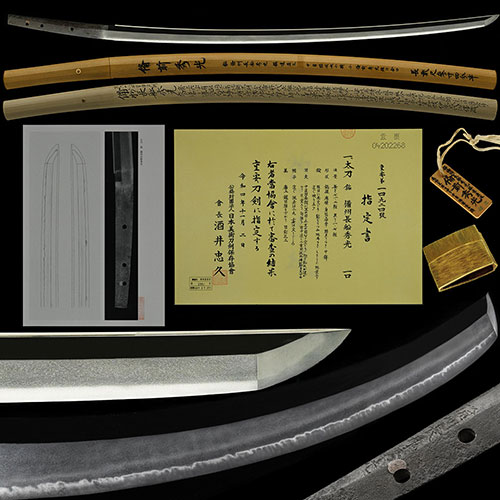
太刀 備州長船秀光 Tachi Bisyu Osafune Hidemitsu
No.083468太刀 備州長船秀光 伊東巳代治伯爵旧蔵 映り立ち直刃調逆足入り地刃明るく冴える屈指の名刀 二尺三寸五分Tachi Bisyu Osafune Hidemitsu Formerly owned by Count Ito Miyoji Utsuritachi Suguha-style, Saka-Ashi entered, Jiba is bright and clear One of the most Outstanding fine sword 71.2cm
お問い合わせAsk
- 銘表Mei-Omote
- 備州長船秀光Bisyu Osafune Hidemitsu
- 登録証Registration
- 神奈川県 Kanagawa 昭和26年3月19日 3/19/26(Showa)
- 時代Period
- 南北朝時代後期Late Nanbokucho period
- 法量Size
-
刃長 71.2cm (二尺三寸五分) 反り 1.7cm
元幅 2.95cm 先幅 1.9cm 元重 0.60cm 鎬厚 0.70cm 先重 0.45cm 鋒長 3.0cm 茎長 19.7cm 重量 700gHachou 71.2cm (二尺三寸五分) Sori 1.7cm
Moto-Haba 2.95cm Saki-Haba 1.9cm Moto-Kasane 0.60cm Shinogi-Thikess 0.70cm Saki-Kasane 0.45cm Kissaki-Chou 3.0cm Nakago-Chou 19.7cm Weight 700g - 国Country
- 備前Bizen
- 姿Shape
- 鎬造、庵棟、身幅広く、反りやや深く、腰反りつき、中鋒。Shinogidukuri, Iorimune, Wide Mihaba, Slightly deep Sori, Koshizori-tsuki, Chu-Kissaki.
- 鍛Kitae
- 板目肌つみ、杢目肌・小杢目肌交じり、地沸微塵に厚くつき、地景よく入り、乱れ映りに棒映り立つ。Itamehada-tsumi, Mokumehada, Mixed Small-Mokumehada, Jinie entered fine and thick, Chikei entered frequently, Midare-Utsuri Bo-Utsuri-tatsu.
- 刃文Hamon
- 直刃調に、片落ち互の目・角互の目など交え、足・葉頻りに入り、逆足よく入り、匂主調に匂口締まり、腰元沸づき、金筋砂流し頻りに掛り、匂口明るく冴える。Suguha-style, Kataochi-Gunome, Mixed Kaku-Gunome, There are many Ashi and You, Saka-Ashi entered frequently, Nioi entered mainly, Nioikuchi-shimari, Koshimoto-Nieduki, Kinasuji and Sunagashi entered frequently, Nioikuchi is bright and clear.
- 帽子Boushi
- のたれ込んで小丸。Notarekonde-Komaru
- 茎Nakago
- 磨上、先切尻、鑢目勝手下り、目釘孔三。Suriage, Sakigirisiri, Yasurime-kattesagari, Mekugiana are three(3).
- ハバキHabaki
- 金着二重。Kinkise Double(Double layered with gold.)
- 説明Drscription
- 秀光は、基光の子で、兼光の孫と伝え、名を右衛門尉といい、南北朝時代貞治から永徳にかけての年紀作がある。南北朝時代の長船正系以外の刀工群を小反りと呼称するが、秀光は、小反りを代表する名工であり、二口が重要文化財に指定されている。また最上大業物に列し切れ味にも定評がある。この刀は、反り深く、腰反りつく美しい太刀姿で、杢目肌に、小杢目肌を交えたつんだ、乱れ映りに棒映り立つ美しい地鉄に、景光と見まごう片落ち互の目を交えた直刃を焼き、腰元に金筋頻りに掛り、匂口明るく冴え、秀光屈指の最高傑作である。Hidemitsu was said to be the son of Motomitsu and the grandson of Kanemitsu, and his given name was Uemon-no-jo. He produced a number of chronological works dating from the Jouji period to Eitoku periods of the Nanbokucho period.
Swordsmiths from the Nanbokucho period other than the Osafune main line are known as kosori swordsmiths, and Hidemitsu is a master swordsmith who represents this style, with his two swords designated as Juyo Bunkazai.
His swords are also ranked among the finest Saijo Owazamono (masterpieces of the highest quality), and are renowned for their sharpness.
This sword has deep Sori, Koshizori-tsuku with beautiful Tachi figure.Mokumehada, Mixed Small-Mokumehada and Tsunda, Midare-Utsuri and Bo-Utsuri-tatsu with beautiful Jigane, Suguha-yaki with Kataochi-Gunome that looks like Kagemitsu, Kinsuji entered frequently with Koshimoto, Nioikuchi is bright and clear.This is one of Hidemitsu's greatest masterpieces.


